 Image search results - "rail" Image search results - "rail" |

Monorail to Chiba Koen Station 千葉公園駅
|
|

View of Chiba Park from monorail. 綿打池
|
|

Seibu Ikebukuro Line train station entrance at Ikebukuro, Tokyo. It takes about 90 min. from Ikebukuro to Yokoze Station via Tokkyu express train. Cheaper trains take 2 hours.
|
|

Ohmi Railways Toyosato Station. MAP
|
|

Inside Toyosato Station.
|
|
|
|
|
|
|

Toyosato Station platform.
|
|
|
|

Nature trail
|
|

Nature trail
|
|

Nature trail into bamboo forest.
|
|

View of Ritto from Mt. Anyoji. Marvelous view if it weren't for the trees...
|
|

View of Ritto from Mt. Anyoji.
|
|

View Hira mountains from Mt. Anyoji.
|
|
|

View from Mt. Anyoji in Ritto.
|
|

View from Mt. Anyoji.
|
|

Mt. Anyoji trail sign totally illegible. No map on the mountain to tell you where ypu are either.
|
|

Small shrine
|
|

Another broken sign.
|
|

View from Mt. Anyoji 安養寺山
|
|

Power line tower on Mt. Anyoji
|
|

Mt. Anyoji from afar looks like a tumulus.
|
|

Ohmi Railways Amago Station, Kora town's only train station. It is parallel to the shinkansen bullet train tracks on the left.
|
|

Ohmi Railways Amago Station platform. The station building (community house) can be seen ahead on the left.
|
|

The Amago Station building is called the Amago Community House. Built in Nov. 2003, it's still quite new, but looks under used.
|
|

Entering Ohmi Railways Amago Station which is also a community house.
|
|

Inside Ohmi Railways Amago Station
|
|

Ohmi Railways Amago Station front view. 尼子駅
|
|

Ohmi Railways Amago Station side view
|
|
|

The ANA (and JAL) Maintenance Facilities are next to each other near Shin Seibijo Station on the Haneda Monorail going to Haneda Airport from JR Hamamatsucho Station.
|
|

Shin Seibijo Station on the Haneda Monorail. ANA's maintenance hangar is a 10-15 min. walk from this station.
|
|

850 meters to Karyoku Koen flower park.
|
|

Entrance/Exit to Karyoku Koen-gawa Tozando
|
|

Getting close to civilization.
|
|

Beware of snakes (mamushi). Never saw any. Never saw any monkeys either.
|
|
|
|

Prevent forest fires.
|
|

Sapporo Station, morning train for Otaru.
|
|

Inside train to Otaru. It takes about 40 min. by regular train, and costs a mere 620 yen.
|
|

My favorite train station name: Zenibako Station. Zenibako means money box.
|
|

The former Temiya Line, Hokkaido's first rail line linking Otaru and Sapporo. It was discontinued in 1985.
|
|

Temiya Line
|
|

Ohmi Railways Echigawa Station. The station building, named Ruburu Echigawa, has a tourist information counter and exhibition gallery.
|
|

Ohmi Railways Echigawa Station platform.
|
|

Ohmi Railways Echigawa Station platform.
|
|

Ohmi Railways train at Echigawa Station.
|
|

Parallel to Echigawa Station is the elevated shinkansen tracks.
|
|

Ohmi Railways Echigawa Station
|
|

Ohmi Railways Echigawa Station platform.
|
|

Railway crossing
|
|

Ohmi Railway track
|
|

Ohmi Railway track
|
|

Ohmi Railways Museum at Hikone Station east exit.
|
|

Ohmi Railways trains on display
|
|
|
|

Inside Ohmi Railways Museum, a pantographThis museum in Hikone closed and reopened inside Yokaichi Station in Higashi-Omi.
|
|

Ohmi Railways Museum display panels
|
|

Inside Ohmi Railways Museum, rail gauges.
|
|
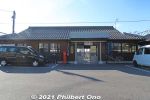
Ohmi Railways Hino Station building was completey renovated in 2017. Very impressive job. Other structures were also renovated including a small railway museum. Renovations were completed by May 2020. 近江鉄道 日野駅
|
|
|
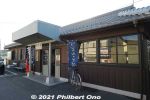
The building is now earthquake-resistant and painted dark brown. It now has a community space for a cafe, tourist information, and waiting room for passengers.
|
|
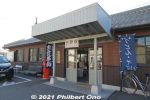
The canopy over the entrance was also renovated. It is supported by entasis columns.
|
|
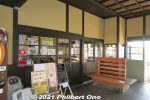
Hino Station's entrance hall. Not so many seats here, but there are benches on the platform. You can also wait inside the cafe on the left.
|
|
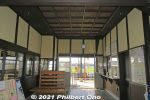
The ticket window used to be on the left corner. Now it's in the right corner. The exit goes to the train platform. The latticed ceiling came from the station's VIP room which was on the right side of the building.
|
|
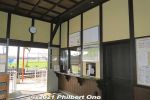
Ticket window on the right (closed).
|
|
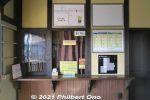
Ticket window (closed). This is new.
|
|
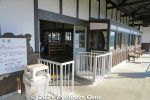
Turnstile
|
|
|
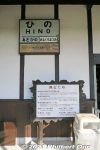
Old Hino Station sign has been in use since the Showa Period (ended in 1989). Displayed on train platform No. 1.
|
|
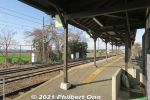
Hino Station train platform.
|
|
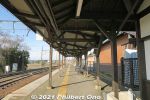
On Hino Station's train platform No. 1. Original wooden columns still usable are retained.
|
|
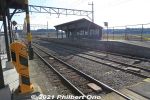
Hino Station has three sets of railway tracks, very rare. The unused middle track is vintage, made by Barrow Steel from the UK. Train platform No. 2 (for Yokaichi/Maibara) across the tracks has a roofed benches also renovated.
|
|
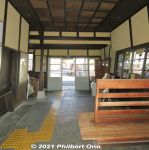
Entering the train building from the platform. Exit ahead.
|
|

Nanairo cafe menu.
|
|
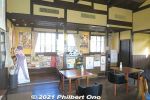
Hino Station now has a nice community space named "Nanairo" that serves as a cafe, tourist information space, and waiting room for passengers. Tourist pamphlets are on the left.
|
|
|
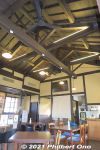
Nanairo cafe has a Western-style truss ceiling from the Taisho Period.
|
|
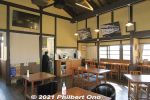
Friendly ladies wait on you for the food or drink. The clock seen on the right was actually used in the train station office.
|
|
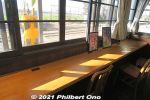
Counter seating has a view of the train platform.
|
|
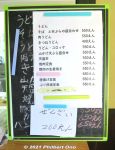
Cafe menu. Low prices. Udon, soba, and teishoku complete meals.
|
|
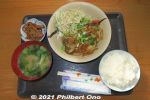
My teishoku lunch.
|
|

Old ticket window and counter have been retained.
|
|
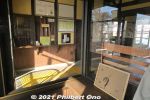
Old ticket window.
|
|
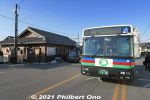
Outside the station is the bus stop for Omi-Hachiman Station.
|
|
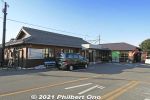
Hino Station (left) and the smaller building on the right used to be the tourist information office. It's now the Hino Station Railway Museum. 日野駅と日野駅鉄道資料展示室
|
|
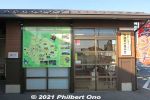
Hino Station Railway Museum. 日野駅鉄道資料展示室
|
|

About the entire Hino Station being a "Railway Museum."
|
|

Inside Hino Station Railway Museum. History of the station on panels, and old train and station-related artifacts. No English captions.
|
|
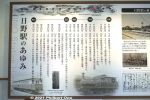
Chronology of the history of Ohmi Railways (founded in 1896) and Hino Station (first built in 1900).
|
|
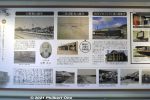
Upper left is a photo of Hino Station's opening day. The back of the station building can be seen. The building was rebuilt in 1916.
|
|
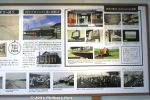
Remnants of the old days still remaining in the renovated Hino Station.
|
|
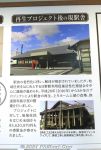
During the renovation, the entire train station building was jacked up to reinforce the foundation against earthquakes.
|
|
|
|
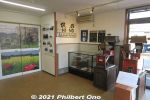
Many of the old artifacts on display can only be recognized or understood by hardcore train fans and people who worked at a train station. It's quite specialized.
|
|
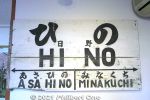
Old Hino Station signage.
|
|
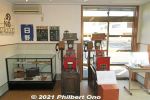
The red instruments are signalling block instruments for preventing collisions between trains. (タブレット閉塞器)
|
|

Implements used by Hino Station staff. Lower left is a paper ticket holder. Preprinted tickets were organized according to the destination.
|
|

L-R: Holder for rubber date stamps used to stamp the date on the ticket. Dating machine to imprint the date on the ticket. Clippers to cutout a small square on the ticket when boarding the train. Magneto telephone with a crank.
|
|
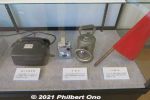
Magneto telephone with a crank (磁石式電話機), signal light, and red signal flag to signal the train.
|
|

On the left are old flyers advertising local businesses in Hino while mentioning Hino Station. Lower right is a roof ornament that has the old crest of Ohmi Railways.
|
|

Ad for a shipping company in front of Hino Station.
|
|
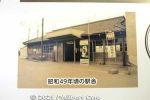
Hino Station in 1974.
|
|
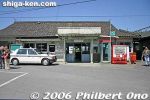
This is what Hino Station looked like before it was renovated in 2019. This old train station building was built in 1916.
|
|

Hino Station on the Ohmi Tetsudo railway before the building was renovated in 2019. On the right was the tourist info office. 近江鉄道 日野駅
|
|
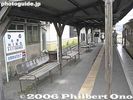
Hino Station platform on the Ohmi Testudo railway. 近江鉄道 日野駅
|
|

Inside Hino Station at night before the building was renovated in 2019. 日野駅
|
|

Hino Station platform at night. Old roof was replaced in 2019.
|
|
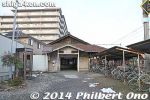
Hikoneguchi Station on the Ohmi Railways. This station building was torn down in Aug. 2014. 彦根口駅
|
|
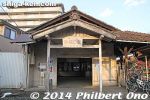
Hikoneguchi Station on the Ohmi Railways first opened in 1901 and renamed Hikoneguchi in 1917. This station building was torn down in Aug. 2014. 彦根口
|
|
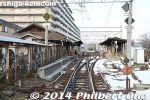
Hikoneguchi Station.
|
|
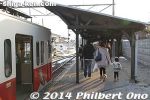
Hikoneguchi Station platform.
|
|
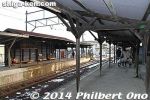
Hikoneguchi Station platform.
|
|
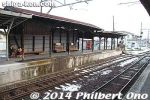
Hikoneguchi Station platform for Kibukawa.
|
|
|
|
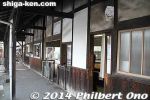
Hikoneguchi Station building before the building was torn down in Aug. 2014.
|
|
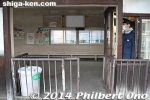
Old Hikoneguchi Station turnstile.
|
|
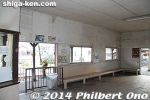
Inside Hikoneguchi Station before the building was torn down in Aug. 2014. No replacement.
|
|
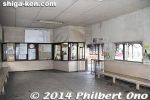
Inside Hikoneguchi Station with turnstile visible, before the building was torn down in Aug. 2014.
|
|
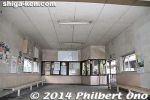
Inside Hikoneguchi Station with turnstile visible, before the building was torn down in Aug. 2014.
|
|
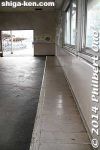
Long bench inside Hikoneguchi Station before the building was torn down in Aug. 2014.
|
|
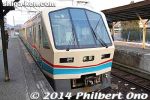
Train for Maibara at Ohmi Railways Hikoneguchi Station.
|
|
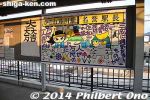
Hikone Serikawa Station. ひこね芹川駅
|
|
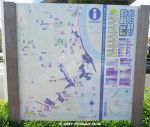
Water & Greenery Corridor (Mizu-to-Midori-no-Kairo) is a semi-urban, hiking trail in the northwestern part of Ichikawa fronting the border with Tokyo along Edogawa River.This part of Ichikawa is dotted with patches, hills, and slithers of small forests, parks, and ponds. This "Corridor" links all this greenery and bodies of water to help protect and preserve the flora and fauna in a coordinated effort by local environmental groups.
This is a map of the trail. Download the official map here: https://www.city.ichikawa.lg.jp/gre01/1111000022.html
|
|
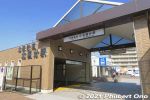
The corridor is 6 km and takes a few hours to walk it between Kita-Kokubun Station (photo) and Konodai Station both in Ichikawa.There are also side treks to other nearby sights. Enjoyable especially when the cherry blossoms are in bloom or during the autumn foliage.
|
|
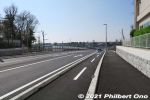
From Kita-Kokubun Station, we walked about 600 meters along this highway until we reached the first green belt.Local environmental groups have been active in trying to preserve and protect the city's nature, but it's an uphill struggle with the encroaching urban development, especially when the Hokuso train line was built through Ichikawa in 1979.
|
|
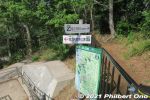
For the most part, the trail has signage in both Japanese and English. We soon got to some greenery called Horinouchi Ryokuchi green belt. There's this fork in the trail. Go left to see the shell mound in Horinouchi Kaizuka Park.
|
|
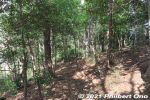
Horinouchi Ryokuchi green belt. 堀之内緑地
|
|
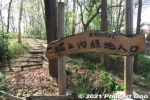
Horinouchi Ryokuchi green belt. 堀之内緑地
|
|
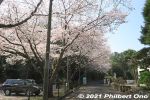
After the small green belt, walk on the street to the Shell Mound.
|
|
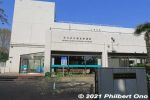
You will pass by the Ichikawa Municipal Museum of History. Free admission, but it was closed when we were there. Horinouchi Kaizuka Shell Mound Park has two museums. 市川歴史博物館
|
|

Horinouchi Kaizuka Park is a flat hill where shells, animal bones, and other food waste were discarded by Jomon people 4,000 years ago. "Kaizuka" means "shell mound." 堀之内貝塚公園This hill was also the site of a Jomon Period human settlement 2,500 to 4,000 years ago. A number of excavations were made since 1904 and ancient human remains, pottery, etc., have been found. National Historic Site.
|
|
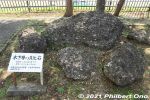
Hardened shell rocks from the ocean 150,000 years ago displayed in Horinouchi Kaizuka Park. These are not shells discarded by humans. 堀之内貝塚公園
|
|
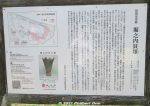
It's hard to discern, but Horinouchi Kaizuka Shell Mound is as long as 225 meters and 100 meters wide. Pink portion in the diagram on the upper left shows where the shells, animal bones (mostly boar and deer) and other food waste were tossed on the hillsides during 4,000 to 2,500 years ago (Jomon Period). They form a horseshoe shape on the hill.
The mound was a central feature of the Jomon Period cluster of homes in this area. Since the late 19th century (Meiji Period), many digs and research on this shell mound have been conducted by archaeologists. However, there are still unknown things about mound.
|
|
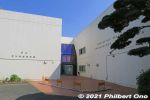
The other museum in the park is the Ichikawa Archaeology Museum displaying shell mound remains as old as 3,000 years (Jomon Period). Pottery & human remains found here are also exhibited. Good to have this museum next to the shell mound. 市川考古�
|
|
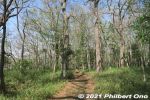
Walking through Horinouchi Kaizuka Shell Mound, larger than what meets the eye. The shell mound's immediate area was the ocean shallows where it was easy to harvest shellfish.
|
|
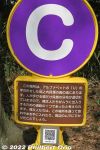
The mound has these alphabetized markers to indicate where the shells are. They form a horseshoe shape (or U shape) on the mound.
|
|
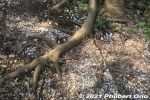
While walking through Horinouchi Kaizuka Shell Mound, we indeed saw many pieces of shell or pottery on the ground.
|
|
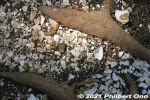
While walking through Horinouchi Kaizuka Shell Mound, many pieces of shell or pottery on the ground. Still here, after thousands of years!Read more about this shell mound here: https://ichikawashi.jp/horinouchi/index_en.html
|
|
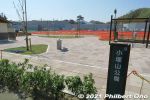
Next was Kozuka-yama Park. There are restrooms. 小塚山公園
|
|
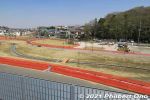
Kozuka-yama Park was still under construction. 小塚山公園
|
|
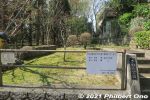
Sawara Park, we walked through here.
|
|
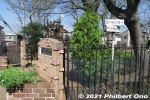
Small athletics field.
|
|
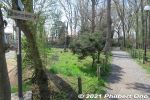
Follow the sign to Konodai Ryokuchi green belt.
|
|
|
|
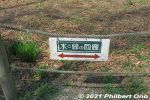
Signage for the hiking trail.
|
|
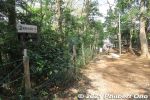
Follow the sign.
|
|
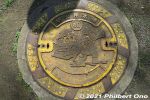
Water hose manhole for firemen.
|
|

Rules for using Junsai-ike Ryokuchi Park. No bicycle riding, dogs must be leashed, etc.
|
|
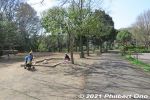
Junsai-ike Ryokuchi green belt park. じゅん菜池緑地
|
|
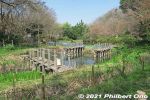
Junsai-ike Ryokuchi green belt park じゅん菜池緑地
|
|

Junsai-ike Ryokuchi Park is a nature area where the flora and fauna are not to be disturbed. じゅん菜池緑地
|
|

If you started the hike at Kita-Kokubun Station, Junsai-ike Pond Ryokuchi green belt park is the first substantial park where you can rest or have lunch. Large pond and cherry blossoms. じゅん菜池緑地
|
|
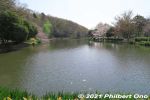
Junsai-ike Pond じゅん菜池
|
|
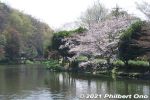
Junsai-ike Pond じゅん菜池
|
|
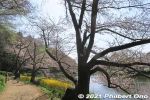
Some cherry blossoms along Junsai-ike Pond in late March. じゅん菜池
|
|
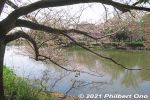
じゅん菜池
|
|
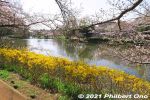
Cherry blossoms along Junsai-ike Pond.
|
|
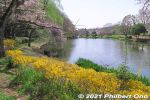
In autumn, Junsai-ike Pond is also noted for fall leaves.
|
|
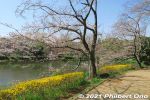
Some cherry blossoms along Junsai-ike Pond. じゅん菜池
|
|
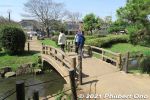
Small bridge in the middle of Junsai-ike Pond.
|
|
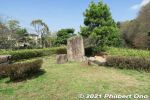
Small island in the middle of the pond.
|
|
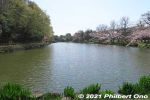
Junsai-ike Pond. No swan boats or rowboats. Only ducks. じゅん菜池
|
|
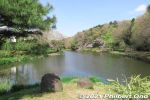
Some cherry blossoms along Junsai-ike Pond. じゅん菜池
|
|
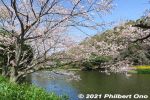
Cherry blossoms along Junsai-ike Pond in late March. じゅん菜池
|
|
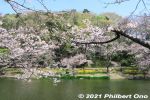
Cherry blossoms along Junsai-ike Pond. じゅん菜池
|
|
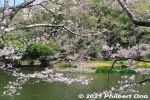
Cherry blossoms along Junsai-ike Pond. じゅん菜池
|
|
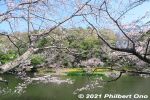
Cherry blossoms along Junsai-ike Pond. じゅん菜池
|
|
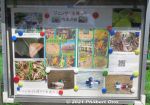
Photos of the park's flora and fauna by a local environmental group.
|
|
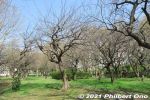
Plum blossom trees near Junsai-ike Pond.
|
|
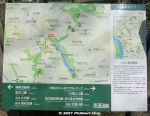
Map and where we are now.
|
|
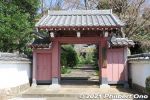
The trail passes by a few temples like Ekoin Betsuin Temple. This is the temple gate. 回向別院
|
|
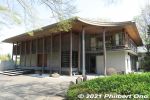
Ekoin Betsuin Temple's main hall rebuilt in 2009. There's actually a cafe (Cafe Terrace Ekoin) on the 2nd floor. It belongs to the Jodo-shu Buddhist sect and is a branch of Ekoin Temple in Ryogoku, Tokyo. 回向院市川別院源光寺
|
|
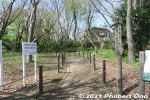
Follow the trail to Satomi Park next.
|
|
|
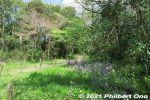
Lush trees and shrubs in Konodai Ryokuchi Park. 国府台緑地
|
|
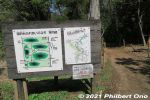
We came out of this trail which goes through into a small forest of different species of trees.
|
|
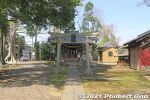
Konodai Tenmangu Shrine dedicated to Michizane, scholar deity. Stone lanterns behind the torii date from 1863. 国府台天満宮
|
|
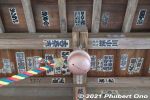
Ceiling and bell.
|
|
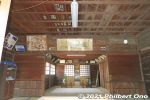
Inside Konodai Tenmangu Shrine. 国府台天満宮
|
|
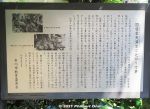
About Konodai Tenmangu Shrine and an event called Tsujikiri.
|
|
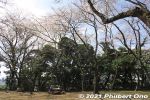
Next is Satomi Park, another large park with different areas. This part is undeveloped and quiet. 里見公園
|
|
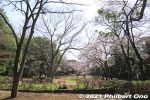
Satomi Park is the site of Konodai Castle occupied by the Satomi Clan who ruled the Boso domain in present-day Chiba during the 16th century. Almost nothing remains though. 国府台城
|
|
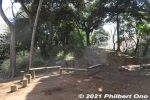
Places to sit in the park.
|
|
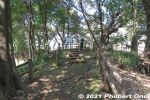
Satomi Park also has the Akedo Kofun burial mound complete with two stone coffins exposed on the mound. 明戸古墳石棺
|
|
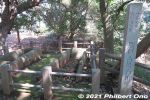
Two stone coffins on Akedo Kofun burial mound. Experts believe that they contained the remains of local nobility who ruled this area in the 6th to 7th century. Chiba Prefecture has many of these stone coffins. 明戸古墳石棺
|
|
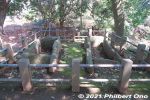
The Akedo Kofun burial mound stone coffins date from the 6th century. They were discovered in 1479. The dirt mound over the coffins fell away to expose the coffins which contained samurai armor, swords, etc. 明戸古墳石棺
|
|
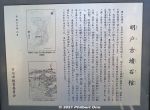
About the Akedo Kofun burial mound. The diagram shows a keyhole-shaped burial mound. The stone coffins are on the top of the round hill. This burial mound has been a noted site since the Edo Period. 明戸古墳石棺
|
|
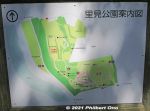
Map of Satomi Park. The burial mound is on the upper part next to the red, dotted oval on the map. The park is next to Edogawa River.
|
|
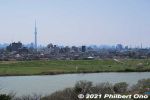
View of Edogawa River from Satomi Park. Across the river is Koiwa and Shibamata. Tokyo Skytree can also be seen. 江戸川
|
|
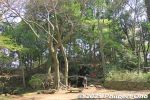
Satomi Park, near the burial mound.
|
|
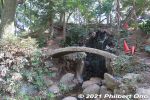
Satomi Park
|
|
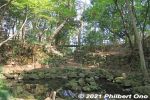
Konodai Castle remains in Satomi Park. Embankments and rocks. 国府台城
|
|
|
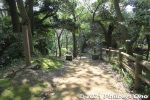
At the top of this small hill is Ichikawa city's highest point (elevation).
|
|
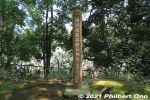
Marker indicating Ichikawa city's highest point (elevation). A whopping 30.1 meters above sea level.
|
|
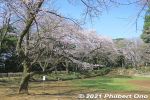
Cherry blossoms in Satomi Park.
|
|
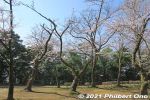
Cherry blossoms in Satomi Park.
|
|
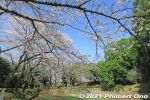
Cherry blossoms in Satomi Park.
|
|
|
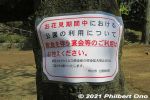
Sign on a cherry tree saying that no hanami flower-viewing picnics are not allowed here due to Covid-19.
|
|
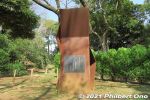
Poetry Monument for So Sakon's poem. 宗 左近
|
|

Poetry Monument for So Sakon's Ichikawa poem. He was a longtime resident and honorary citizen of Ichikawa . 宗 左近
|
|
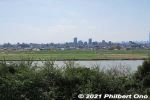
Edogawa River.
|
|
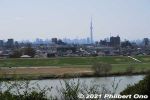
Edogawa River and Tokyo Skytree as seen from Satomi Park.
|
|
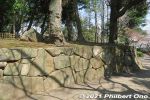
Castle-like stone foundation.
|
|
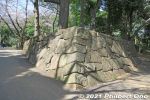
Castle-like stone foundation. Satomi Park is the site of Konodai Castle. However, this stone foundation is not original.
|
|
|
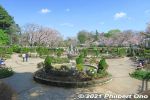
Satomi Park water fountain. This is another area of the park. Totally different landscape. This was the main site of Konodai Castle. 国府台城
|
|

Satomi Park water fountain.
|
|
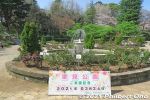
Satomi Park visit date.
|
|
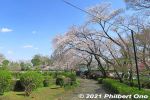
Satomi Park cherry blossoms.
|
|
|
|
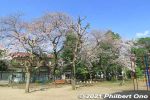
Satomi Park playground.
|
|
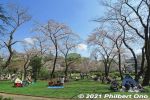
This is where most people enjoyed Satomi Park, under the cherry blossoms.
|
|
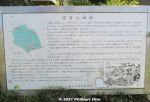
Being the site of Konodai Castle, Satomi Park was also the site of the Battles of Konodai fought twice between the local Satomi Clan (ruler of Awa Province in present-day Chiba) and the invading Hojo Clan (from Odawara) in the 16th century. The Hojo won the final battle and thereby took control of present-day Chiba. The Hojo is said to have expanded and reinforced Konodai Castle.
However, when Tokugawa Ieyasu took control of Japan, he had Konodai Castle dismantled because it had a intimidating view of his own Edo Castle.
|
|
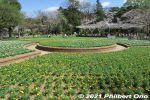
During World War II, Satomi Park was an Imperial Army base camp. It finally became a public park in 1959. Flower beds now cover the site of Konodai Castle.
|
|
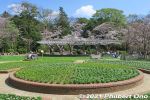
Satomi Park is also noted for roses in early summer and fall. The rose is Ichikawa's official flower.
|
|
|
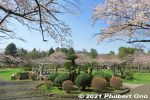
Flowery site of Konodai Castle in Ichikawa, Chiba. No castle buildings. 国府台城跡
|
|
|
|
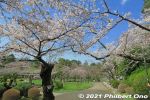
Nice cherry blossoms at Satomi Park, Ichikawa.
|
|
|
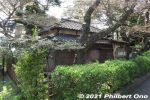
Satomi Park also has Shien-soja (紫烟草舎), the former home of famous tanka poet named Kitahara Hakushū (1885–1942) (北原白秋). He lived in this house for only a year in 1916.
|
|

About Shien-soja. It was originally located in Koiwa (Edogawa Ward, Tokyo) and moved here. (紫烟草舎).
|
|
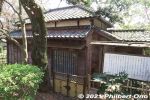
Shien-soja (紫烟草舎).
|
|
|
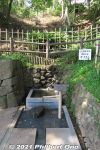
Old well on the fringe of Satomi Park named "Rakan-no-I". 羅漢の井
|
|
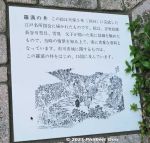
The Rakan-no-I well was actually depicted in this 1834 illustration, part of Illustrations of Edo's Noted Sights. 羅漢の井
|
|
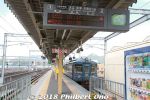
At JR Fukuchiyama Station, Kyoto Tango Railways operates a special tourist train named "Aomatsu" to Amanohashidate. It's just one train car.It's a cafe train that serves drinks and light meals.
JR Fukuchiyama Station is a major gateway to northern Kyoto Prefecture because it is a terminal station for Kyoto Tango Railway, the dominant train network in this area.
|
|
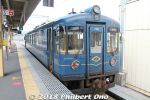
The Aomatsu train runs once every morning (10:17 am) and afternoon (3:17 pm) from Fukuchiyama Station to Amanohashidate Station and requires no reservations or extra train fare.
|
|
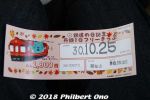
This Kyoto Tango Railways one-day train pass is a good deal.
|
|
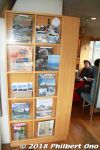
Enter the Aomatsu train and see this rack of tourist pamphlets.
|
|
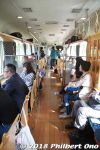
Aomatsu is special because the interior is wooden and it has a variety of seating (train fare is the same for all seats).It's a cafe train and you can order drinks (including alcohol) and light meals. No reservations required, and it's all non-reserved. Train fare is the same as regular trains.
|
|
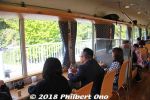
Window seats at the counter.
|
|
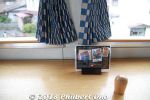
Counter seat with a knob to hold on to.
|
|
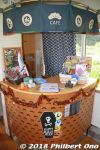
There's a staffed bar where you can order drinks and food.
|
|
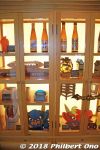
Wooden showcase.
|
|
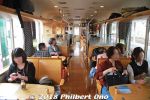
Cafe-type seats (wooden) with a table.
|
|
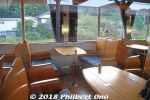
Cafe-type seats (wooden) with a table.
|
|
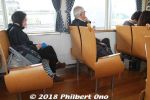
Toward the front of the train are regular seats.
|
|
|
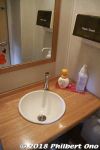
Bathroom sink.
|
|
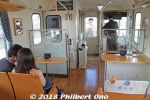
Front of the Aomatsu train.The Aomatsu train runs only twice a day from Fukuchiyama to Amanohashidate taking about an hour. Love this train.
https://trains.willer.co.jp/matsu/aomatsu.html
|
|
| 1186 files on 5 page(s) |
1 |
 |
 |
|